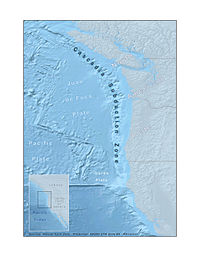
Photo from wikipedia
The high noise levels of high-rate Global Navigation Satellite System (GNSS) solutions limit their seismological applications, including capturing earthquake-induced coseismic displacements. In this study, we developed a new adaptive denoising… Click to show full abstract
The high noise levels of high-rate Global Navigation Satellite System (GNSS) solutions limit their seismological applications, including capturing earthquake-induced coseismic displacements. In this study, we developed a new adaptive denoising approach for high-rate GNSS observations to improve the precision of seismic displacements and preserve seismic waveforms in GNSS coseismic signals. The performance of the proposed method was evaluated using high-rate (5 Hz) GNSS data acquired from the moderate EI Mayor–Cucapah earthquake (Mw 7.2) on 4 April 2010 and the small Brawley seismic swarm (Mw 4.6–5.5) on 26 August 2012. The performance of the proposed method was compared with those of modified sidereal filtering, Stacking filtering, and MSF plus Stacking. The comparison showed that the proposed method is more precise than other widely used method. It can significantly remove high-frequency white noise and low-frequency colored noise caused by CME, multipath errors, and/or other unmodeled systematic errors in high-rate GNSS displacements. The results were also compared with collocated strong motion data (50 and 200 Hz). The high precision of the proposed method was mainly afforded by the high performance of complete ensemble empirical mode decomposition, which was used to decompose the GNSS signal into different frequency modes. However, the normalized autocorrelation function and correlation coefficients used to determine the noise-dominated high-frequency modes and the “wavelet-like” soft-threshold used for direct denoising of the noise-dominated high-frequency modes also contributed. Despite the high noise levels of GNSS solutions, especially regarding the vertical displacement components, some small-amplitude details, which are usually only detectable by seismic instruments, could be observed in the denoised displacements in this study. The results reported herein indicate that the proposed method significantly improves the precision and reliability of GNSS displacements and the effectiveness of seismic signal detection, which is particularly critical for the measurement of earthquake-induced coseismic displacements.
Journal Title: IEEE Access
Year Published: 2019
Link to full text (if available)
Share on Social Media: Sign Up to like & get
recommendations!